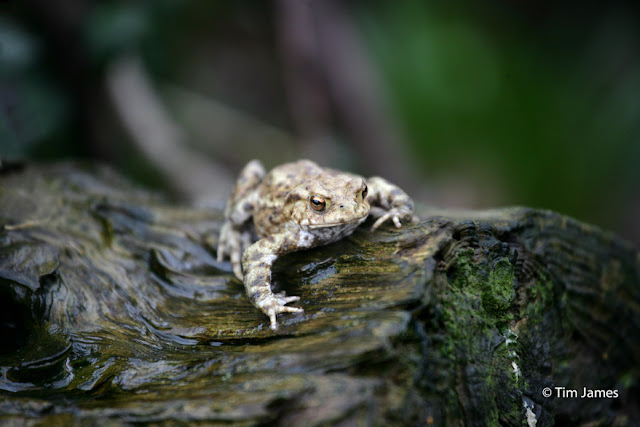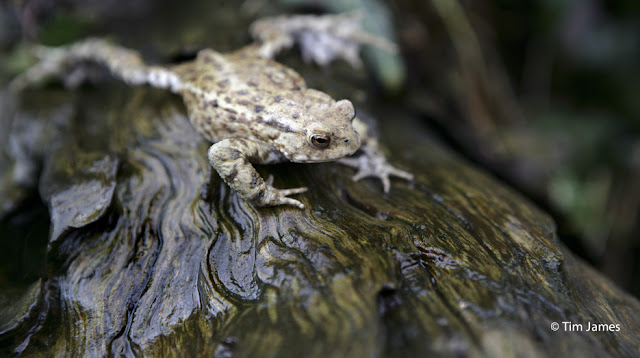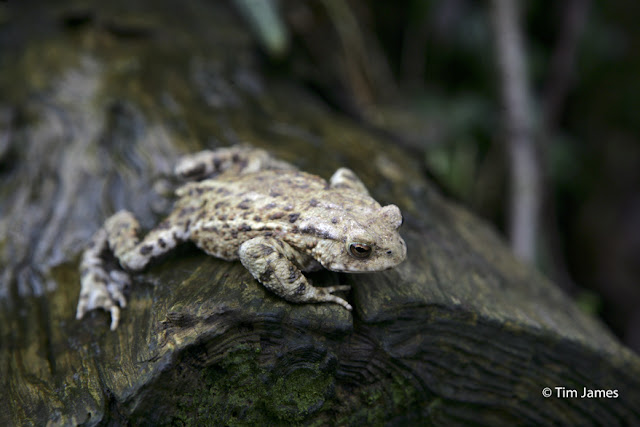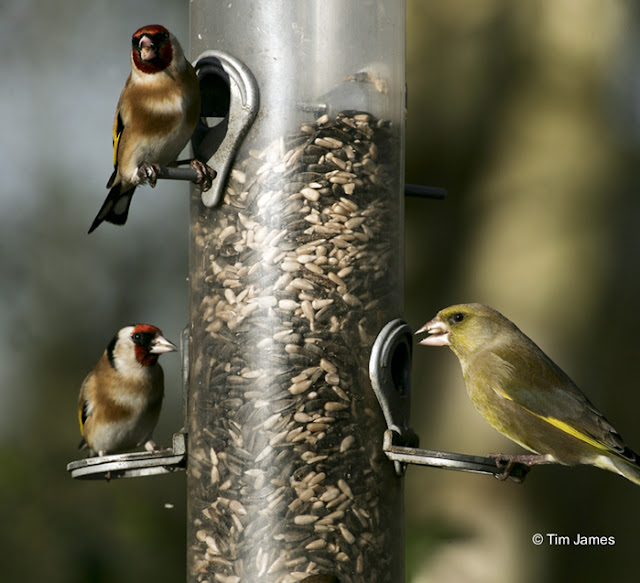Another brief collection of shots of birds in flight around a feeder, this time a trio of finches and a tit. I like trying to capture smaller birds in flight – unless the light is perfect, photographically it can be challenging – a fast enough shutter speed to freeze the action, while maintaining an aperture size wide enough to allow in enough light is a fine balancing act. But I think it's worth it; images of branch-bound songbirds abound, but there are far fewer showing what birds do best.
20110227
20110226
Common Frog
I rescued this Common Frog from my cat (on some images you may still be able to pick out a few stray feline hairs) and carefully placed it on this log in my garden, hoping it would not immediately leap off and disappear into the undergrowth. It complained a little – letting out a plaintive mid-pitch mini-croak, not unlike – ironically – a kitten's mew. But as it was, as a model the frog couldn't have been more obliging. With cloud cover meaning little available light, I mounted the camera on a tripod while the frog slowly explored its new surroundings. They are, I think, wonderful little creatures, each a unique mix of markings and each subtly different in their colouring, from a deep green-brown to almost olive. This one – a female, I think (the males have a hard swelling on the first finger to grasp their partner during mating) – was more sandy. The Common Frog is, as its name suggests, widespread throughout the UK, but still, I think, a magical sight.
Canon 1Ds MkII, 1/125-250 sec, f/2.8-6.3, 70mm at ISO 500
Canon 1Ds MkII, 1/125-250 sec, f/2.8-6.3, 70mm at ISO 500
20110224
Just because I like the shot
Nothing more, nothing less. A common or garden Blue Tit, but I like the simplicity of the image and the detail in the bird's twig-like legs and feet as it grasps on – somehow – to a feeder pole that would seem to offer no chance of any purchase.
Canon 1Ds MkII, 1/400 sec, f/4, 200mm at ISO 400
Canon 1Ds MkII, 1/400 sec, f/4, 200mm at ISO 400
Blackbird
Labels:
Blackbird (Turdus merula)
I know, it's just a humble Blackbird. But I actually think they're very attractive birds. In the right light the black feathers have a real sheen and those brilliant orange-ringed eyes are stunning.
Canon 1Ds MkII, 1/2,000 sec, f/4, 200mm at ISO 800
Canon 1Ds MkII, 1/2,000 sec, f/4, 200mm at ISO 800
Greenfinch
Labels:
Greenfinch (Carduelis chloris)
Another shot attempting to catch the action of flight, this time a Greenfinch. I particularly enjoy the way the finch seemingly has eyes for only one thing.
Canon 1Ds MkII, 1/1,000 sec, f/5.6, 268mm at ISO 800
Canon 1Ds MkII, 1/1,000 sec, f/5.6, 268mm at ISO 800
Chaffinch on the Wing
Labels:
Chaffinch (Fringilla coelebs)
It was so wonderful today to see the return of some sunshine after week after week of endless grey. I took the opportunity to spend an hour in the hide close to the bird feeder, hoping the improved light would offer up the chance of shooting some finches in flight. As it was, the sun chose that moment to hide behind thin cloud and the conditions were not ideal. Undeterred, however, I bumped up the ISO, opened up the aperture and left focus almost to chance and managed a few shots. None is terribly sharp and all suffered from inevitable noise issues, but these two are fun.
Canon 1Ds MkII, 1/1,000 sec, f/5.6, 268mm at ISO 800
Canon 1Ds MkII, 1/1,000 sec, f/5.6, 268mm at ISO 800
20110220
Barn Owl
Labels:
Barn Owl (Tyto alba)
Barn Owls do exactly what it says on the tin. They have evolved to be silent hunters and they do it with graceful efficiency. They possess, of course, impressive talons: four toes, three of which face forward when the bird is in flight and the uniquely flexible outer front toe on each foot can swivel round to face backwards when the bird is at rest. The bone structure in the Barn Owl's feet are also shorter and stronger than the equivalent bones in most other birds, giving this consummate hunter an advantage – these high-stress limbs can withstand the considerable relative force of an impact with its prey. But in these images, I've concentrated on body feathers and the organs that provide the owl with super-senses – its eyes and the ears. Compared to most birds, Barn Owls have a very low wing loading, meaning that relatively large wings support a relatively small body mass. Its feathers are very soft, another adaptation for quiet flight, and they are covered in a discreet layer of tiny hairs that trap air within the feather surface. In addition to these adaptations, the Barn Owl's foremost wing feather (the 10th primary) has a row of tiny hooks that help to deaden the sound of air hitting the wings' leading edge. Together, these adaptations mean almost silent flight is possible, allowing ambush by stealth twinned with the ability to detect the small sounds produced by their small mammal prey. In January, I found a dead, ringed Barn Owl on the farm on which I live and – once I had passed on details of the release data to the BTO – I took the opportunity to examine its unique auditory set-up. The owl's heart-shaped face – the equivalent of our outer ear – acts like a huge radar, picking up and directing even the most delicate sounds into the inner ear. And those inner ears – hidden beneath its head feathers and each of them different in shape and sited asymmetrically with one higher than the other – mean the bird can further compute the signals received to finesse its hunting plan. Then there are the eyes. Huge in comparison to the size of the head and twice as sensitive to light as our own eyes, the owl can hunt for prey in near darkness and, with details in what we would see as shadows, the bird can detect even the slightest movement in the blackness. A most beautiful killer…
Source: The Barn Owl Trust ( www.barnowltrust.org.uk )
Canon 1Ds MkII, 1/640 sec, f/4, 180mm at ISO 500

Red Deer hinds
Labels:
Red Deer
I was drawn to the two sets of two in this shot. The Red Deer hinds were on high alert, ears pricked up as they became aware of my presence, so I backed off a little. But not before noticing the two cock Pheasants walking across the shot.
Canon 1Ds MkII, 1/80 sec, f/8, 400mm at ISO 500
Canon 1Ds MkII, 1/80 sec, f/8, 400mm at ISO 500
20110215
Long-tailed Tit and Blue Tit
Labels:
Long-tailed Tit
Another one of those happy accidents that photography serves up every once in a while. This shot was taken on a gloomy day, with fast shutter speeds near impossible without considerable commensurate noise from a bumped up ISO. In the end I was shooting at 1/25 sec and not hoping for much. I was trying to capture a shot of this Long-tailed Tit sitting on a branch alongside a Blue Tit. Though they obliged by dwelling a while, even the slightest movement meant a blurred shot. The lack of sharpness on the Long-tailed Tit means this is no gallery image. But the framing of its body in the wing movement of the fleeing Blue Tit is a serendipitous composition.
Canon 1Ds MkII, 1/25 sec, f/8, 400mm at ISO 640
Canon 1Ds MkII, 1/25 sec, f/8, 400mm at ISO 640
Tiger
I make no apologies for including another brace of zoo images – partly because it's been so horribly grey here and I haven't been out shooting, but principally because these majestic creatures need all the help they can get. According to the WWF, three tiger sub-species – the Bali, Javan, and Caspian – have become extinct in the past 70 years. The six remaining sub-species – the Amur, Bengal, Indochinese, Malayan, South China, and Sumatran tigers – are all threatened by poaching and habitat loss. Indeed, in the last 100 years, tiger numbers have fallen by a staggering 95%, with only an estimated 3,200 now left in the wild. For more, visit http://www.worldwildlife.org/species/finder/tigers/index.html
1. Canon 1Ds MkII, 1/250 sec, f/8, 400mm at ISO 640
2. Canon 1Ds MkII, 1/80 sec, f/10. 400mm at ISO 640
Both images alas shot through glass
1. Canon 1Ds MkII, 1/250 sec, f/8, 400mm at ISO 640
2. Canon 1Ds MkII, 1/80 sec, f/10. 400mm at ISO 640
Both images alas shot through glass
20110213
Red Panda
Labels:
Red Panda (Ailurus fulgens)
I've tried on a number of occasions to photograph one of the captive Red Pandas at Banham Zoo in Norfolk, but on every occasion this shy and solitary creature has alluded me. This one, however, was feeling positively social, happy to munch on fruit atop a log frame. The Red Panda (Ailurus fulgens) is native to the eastern Himalayas and south-western China. It is the only species of the genus Ailurus. It feeds mainly on bamboo, but is omnivorous and may also eat eggs, birds, insects, and small mammals. The Red Panda has been classified as vulnerable by the International Union for the Conservation of Nature (IUCN) because its population is estimated at less than 10,000 mature individuals. The usual suspects line up as the reasons behind its continuing decline – habitat loss and fragmentation and poaching.
Canon 1Ds MkII, 1/160 sec, f/9, 318mm at ISO 640
Otter
Labels:
Otter
This wildlife park dog Otter had grown so accustomed to being fed fish by the keepers on a regular basis that it cried incessantly when I opened my kit bag to take this shot. I never wanted an image that appeared to have been taken in the wild, but I was looking for a shot that at least didn't look unnatural. I rejected pictures taken where the Otter was crying while standing on its hind legs in favour of this more naturalistic composition. The many initiatives to boost Otter numbers in the UK are achieving huge successes and improved water quality in many areas is also paying dividends. But numbers are still very low and an Otter in the wild remains one of my must-get shots…
Canon 1Ds MkII, 1/50 sec, f/8, 344mm at ISO 400
Canon 1Ds MkII, 1/50 sec, f/8, 344mm at ISO 400
Bald Eagle
Labels:
Bald Eagle
I shot this truly statuesque Bald Eagle at a small zoo on one of those English winter days when the sky was leaden and there was rain in the air. I'd shot other eagles at the site before, but this time the aim was to try to achieve something with more of a painterly quality. So I opened up the aperture to blur and black out the background and upped the shutter speed to knock back the body feathers. With the Bald Eagle, there's little chance of the white head plumage being lost. I'm thrilled with the result.
Canon 1Ds MkII, 1/1600 sec, f/4, 200mm at ISO 640
Canon 1Ds MkII, 1/1600 sec, f/4, 200mm at ISO 640
20110211
Long-tailed Tit
Labels:
Long-tailed Tit
I'm getting so weary of the absence of decent light. One day of bright sunshine in the past three weeks, the remaining days – many of them my 'black and white' days – spent struggling with high ISO settings and slow, movement and blur-inducing shutter speeds. Sometimes, however, I get lucky and this shot of a Long-tailed Tit is just about sharp, even at 1/25 sec. More luck than skill…
Canon 1Ds MkII, 1/25 sec, f/8, 400mm at ISO 640
Canon 1Ds MkII, 1/25 sec, f/8, 400mm at ISO 640
Blue Tit
Labels:
Blue Tit (Cyanistes caeruleus)
Just because I like the composition – the strong vertical and the strong horizontal.
Canon 1Ds MkII, 1/160 sec, f/8, 400mm at ISO 640
Canon 1Ds MkII, 1/160 sec, f/8, 400mm at ISO 640
Barn Owl
Labels:
Barn Owl (Tyto alba)
I'm trying hard to wean myself of my obsession with getting close; very close if I can. Too often I miss a cracking shot simply because I have attempted to get too intimate with the subject and – inevitably – have been rumbled and the bird/mammal/rodent has shot off out of the viewfinder. I dream, of course, of one day having in my armoury a Canon EF 800mm f/5.6 IS USM lens. I really do believe that if I had such a lens my world would be a better place. If I had that lens, I would only take great shots. That's nonsense, of course. In reality, the key to great wildlife images doesn't lie in bigger, better lenses, but in fieldcraft. And I'm learning slowly that sometimes better images come from context. This shot of a resting Barn Owl is, I think, a good example. Had I been closer, had the day not been another expanse of endless grey cloud that rendered everything flat, and had I had at my disposal a longer lens with wider aperture settings then I would no doubt have captured another close-up shot of an owl. But would it have been a good shot? Would it have added anything? Probably not. Instead, I think this shot – the bird in the context of its surroundings and showing it not hunting, but simply stopping up for a while – is rewarding for me partly because it's not too up close and personal.
Canon 1Ds MkII, 1/320 sec, f/9, 400mm at ISO 800
Canon 1Ds MkII, 1/320 sec, f/9, 400mm at ISO 800
Norfolk coast
I thought it might be nice to place this blog in some sort of context. Much of my photography is done in North Norfolk and I think this image – taken during December 2010's heavy snowfalls – illustrates why it's a privilege to live here. Mile after mile of unspoilt coastline, the huge skies, the magical light (when it's not interminably grey), the special allure of the saltmarshes and countless well-run nature reserves combine to make it the perfect place in which to indulge my passion (read obsession).
Canon 1Ds MkII, 1/200 sec, f22, 17mm at ISO 200
Canon 1Ds MkII, 1/200 sec, f22, 17mm at ISO 200
Song Thrush
This Song Thrush seemed perfectly content picking up the scraps of peanuts and seeds dropped or discarded by a veritable army of tits feasting at a feeding station above. A beautiful bird in its subtlety of tones.
Canon 1Ds MkII, 1/100 sec, f8, 376mm at ISO 1,000
Canon 1Ds MkII, 1/100 sec, f8, 376mm at ISO 1,000
Barn Owl
Labels:
Barn Owl (Tyto alba)
This large, mature Barn Owl had been quartering a large area of uncultivated pasture in the shadow of one of North Norfolk's many rural churches. On a rather gloomy day and some distance from the owl, I had failed in my efforts to get a decent shot of the bird hunting and I missed its swoop on to something in the long grass. But when it showed itself again, I was able to get this image of it guarding its prey with a look that seems to say: "It's mine – be gone with you".
Geese in flight
The sheer number of geese that fly in over Norfolk during the winter months is awe-inspiring. Usually, I hear them before I see them – the air filled with their honking – and on this occasion I was able to capture this skein of geese (are they Barnacles?) in the same quadrant of the sky as this airliner heading north, presumably over Scotland en route to the USA. Can't help but speculate on how much more arduous the geese's journey must have been.
Canon 1Ds MkII, 1/160 sec, f 6.3, 200mm at ISO 100
Canon 1Ds MkII, 1/160 sec, f 6.3, 200mm at ISO 100
20110210
Limited-edition prints
I'm lucky enough to have a selection of my work on show in a gallery within an 18th century barn farm shop here in beautiful North Norfolk. Some of them are reproduced here. Each is limited to 20 signed giclée prints on archive quality 420gsm paper. Anyone interested in any of the prints, which can be framed to the buyer's specification, should contact me through this site. The farm shop – Back to the Garden – is situated just outside Holt and is well worth a visit. ( http://www.back-to-the-garden.co.uk/ )
20110208
Goldfinch
Labels:
Goldfinch (Carduelis carduelis)
If – by some huge stretch of the imagination – I were ever to find myself in the position of being able to rename key avian species, I think I would start with the finches common to the UK. To my eye, the Greenfinch is more golden than the Goldfinch, whose own distinct head colouring would surely lend itself to being re-branded the Redfinch. That would leave the Chaffinch, whose powder blue head would warrant the name of the Bluefinch. That would leave the Bullfinch and I guess that name should stick – few birds look quite the bruiser more than that one.
Canon 1DS MkII, 1/500 sec, f8, 326mm at ISO 200
Canon 1DS MkII, 1/500 sec, f8, 326mm at ISO 200
Collared Dove
This Collared Dove was simply waiting on this tree branch for its turn at a feeder. Such a familiar bird, but in its way rather attractive. The grey of its breast has a purplish tint in certain lighting conditions and the red tint to its eyes is subtle but beautiful. What I like about the shot is the early afternoon light; the deep blues of the woodland behind the dove seem to complement its colouring perfectly and the yellows and greens of the branch are echoed behind the bird's left wing. One of those magical occasions when everything came together to result in a simple but rewarding image.
Canon 1DS MkII
1. 1,1000 sec, f8, 400mm at ISO 200
2. 1/500 sec, f8, 400mm at ISO 200
Canon 1DS MkII
1. 1,1000 sec, f8, 400mm at ISO 200
2. 1/500 sec, f8, 400mm at ISO 200
Black-winged Stilt
Labels:
Black-winged Stilt
I confess to not having known a great deal about this graceful wader prior to having taken this shot. I know now that it is only a rare visitor to Britain (between April and Setember) and it has bred here. What I was drawn to through the camera lens was the bird's utter elegance, stunning livery (the black wing feathers have an almost satin sheen) and, of course, that fortuitous water droplet at the end of its beak.
Canon 1DS MkII, 1/250sec, f8, 298mm at ISO 200
Canon 1DS MkII, 1/250sec, f8, 298mm at ISO 200
Chaffinch in song
This shot was taken on the most glorious of February days; a frost on the ground, a distinct chill in the air and the clearest of blues skies above. Such a day had been a long time coming and I was determined to capture an image that conveyed the sense that spring wasn't too far away. This male Chaffinch lost in song seems to do the job rather nicely.
Canon 1DS MkII, 1/250 sec, f8, 400mm at ISO 200
Canon 1DS MkII, 1/250 sec, f8, 400mm at ISO 200
Red Squirrel
The plight of the Red Squirrel in the UK is well documented; there are estimated to be just 140,000 left in Britain compared to more than 2.5 million Grey Squirrels (source: Forestry Commission). There are small strongholds in Scotland, northern England (notably in Cumbria) and Wales, but elsewhere geography is the red's only hope. It is on islands that the future for the Red Squirrel looks just a tad brighter; islands such as Anglesey, where it was once widespread. That was the position until the 1970s, when the invasive grey began to be seen in numbers. The theory is that they either crossed to the island on one of its two bridges or they – almost unbelievably – swam across the Menai Straits. What is clear, however, is that the population of the Red Squirrel in Anglesey has plummeted to the extent that there are now only around 200 adults (source: Friends of Anglesey Red Squirrels). Greys are now being live-trapped and a major Red Squirrel reintroduction programme is having success. These shots of captive Red Squirrels were taken at Pensthorpe nature reserve in Norfolk, which is part of the Anglesey programme, with healthy adult reds being relocated to Anglesey in a bid to shore up the resident population.
Canon 1DS MkII
1. 1/200 sec, f8, 400mm at ISO 640
2. 1/100 sec, f8, 252mm at ISO 640
Canon 1DS MkII
1. 1/200 sec, f8, 400mm at ISO 640
2. 1/100 sec, f8, 252mm at ISO 640
Barnacle Goose
I've included this shot simply because I enjoy the tranquility of the moment. Shot contre-jour, there was never going to be much detail in the picture, but if anything I think that only adds to the atmosphere.
Canon 1DS MkII, 1/2000 sec, f8, 308mm at ISO 200
Canon 1DS MkII, 1/2000 sec, f8, 308mm at ISO 200
Coot
Relatively weak fliers, Coots seem almost as happy on land as they are on the water. They can run vigorously on strong legs and possess long toes adapted to uneven surfaces. Coots also tolerate the presence of humans better than many more nervous avian species. This one – foraging for grass shoots or small insects – seemed not to mind a jot the presence of the camera. With a Coot, however, the head is rarely still and I had to lay for some time until I got the focus sharp on the bird's beak and eye.
Canon 1DS MkII, 1/640 sec, f8, 400mm at ISO 200
Canon 1DS MkII, 1/640 sec, f8, 400mm at ISO 200
Blackbird
I love the emphasis on the eyes of this male Blackbird as it focuses hard on something in the distance; a food source perhaps or a possible predator. In birds, the eyes are the largest organs relative to their body size. Our eyes take up a mere 1% of the total weight of our heads, while most of the avian eye lies hidden by the skull and eyelids. The eyes of large owls are about the size of our own, but can account for one third of the weight of their heads. Starlings' eyes make up 15% of their head weight. In many birds, the eyes weigh more than the brain. Little wonder, then, that those who like to photograph birds so often need the subterfuge of a hide.
Canon 1DS MkII, 1/320 sec, f8, 400mm at ISO 200
Canon 1DS MkII, 1/320 sec, f8, 400mm at ISO 200
Subscribe to:
Posts (Atom)


















































